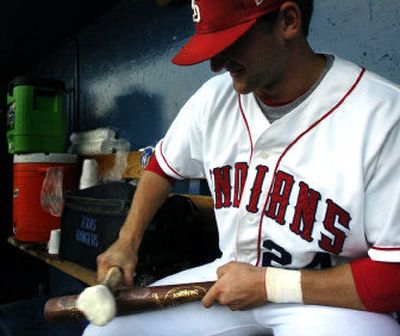Make no bones about it

When Steve Egger was approached by the Spokane Indians about donating a cow bone to the team so players could use it to rub their bats, the owner of Egger’s Better Meats in the South Hill was, of course, curious.
It was the first time he had heard of baseball players wanting – needing – a bone to improve their batting average.
With steroids being such a big issue, many, like Egger, wouldn’t think that a bone could make a bat stronger and harder.
But it does. The more times a bat is used, the more the grains of the wood widen. The wider the grains are, the easier it is for the wood in the bat to peel, chip or break.
For the past three weeks, Indians players have been rubbing their bats with the femur bone of a cow to push down the grains of the wood to make their bats stronger.
“It is a process that is done to compress the grain, keep the barrel more durable,” said Chuck Schupp, who runs the pro bat sales team at the Louisville Slugger Hall of Fame in Louisville, Ky. “I haven’t seen it done in the major leagues for several seasons. Maple (wood bats) has filled the barrel hardness void in the current-day player.”
Babe Ruth used to do it. So did Joe DiMaggio. It’s called bone rubbing, or bat boning, and it’s as old as the game itself.
“Its old school,” said Indians manager Gregg Riddoch. “But you can do it on anything. Back in my day, players would use the old coke bottles because it had the ridges. It would leave the bats real smooth.”
Before getting the bone from Egger three weeks ago, most Indians players where using the sink inside the clubhouse to push down the grains on their bats.
“The bone makes it easier,” said Steve Murphy, the owner of the bone. “It is portable and you can take it to the dugout, in case a bat breaks and you need to bone a bat real quick, or the on the road.”
Not every bat is to be rubbed. Maple wood bats, for example, come with a finish on the barrel that makes it harder and more durable.
“They (maple bats) don’t splinter as much,” said Indians outfield Joe Kemp, who held up two bats to show the difference. On one bat, an ash wood bat, the grains are noticeable. On his bat, a maple wood bat, there are no grains.
“Maple is harder,” Kemp said.
Maple bats don’t require the same maintenance as ash wood bats to last as long, but they are lighter.
That’s why many players use them, such as Indians shortstop German Duran.
“They are not sturdy and break every three games,” said Duran. “But they allow me to react to a pitch faster.”
Duran, however, doesn’t believe in bone rubbing.
“That’s a little superstitious,” he said.
Instead, Duran does other things to preserve the bat, such as using a different bat for batting practice and placing it down carefully, rather than just throwing it down.
“You kind of get attached to your bat and don’t want it to break,” said Murphy. “It (rubbing the bat with the bone) just helps prolong the life of a bat.”
Egger still doesn’t know exactly how bone rubbing works, but he had heard weird requests before.
“I’ve given out bones for many things,” said Egger, “For special recipes, for medicinal purposes, but I had never given a bone to rub on a bat before. I’m just happy to have helped out.”